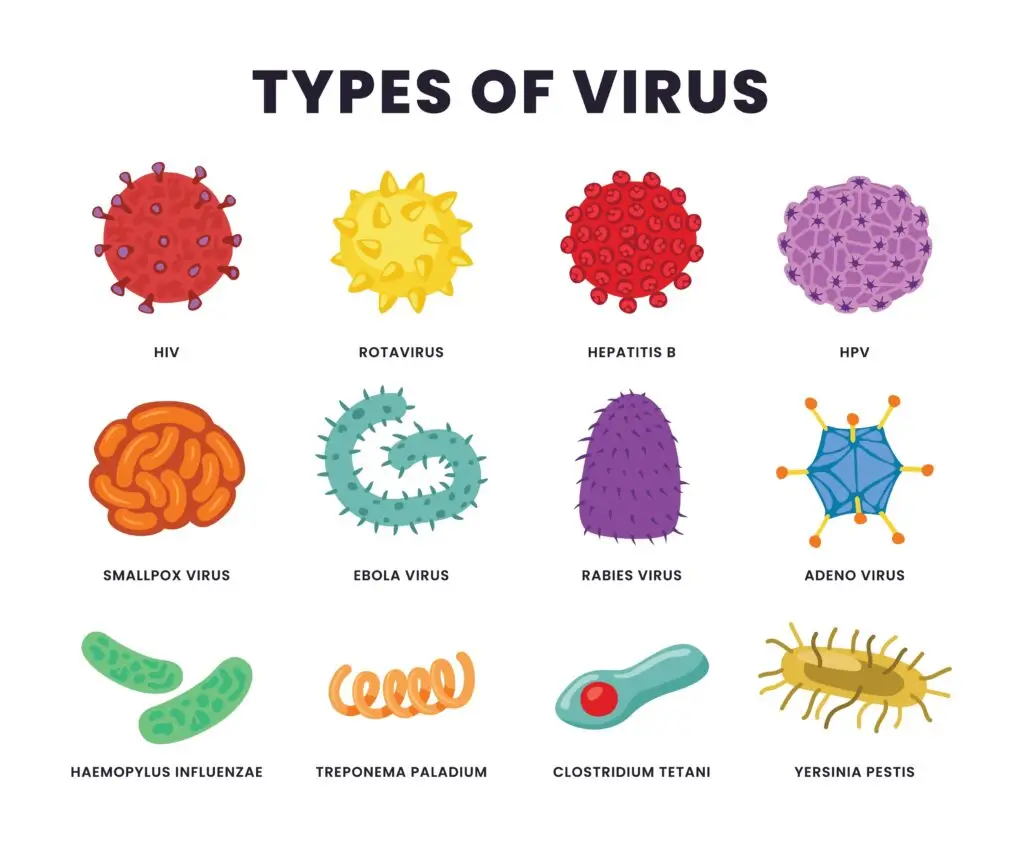Virus
What is a Virus?
A virus is a microscopic infectious agent that exists at the boundary between living and nonliving entities. Unlike living cells, viruses lack the ability to carry out metabolic processes, such as generating energy or synthesizing proteins, on their own. Instead, they rely entirely on the cells of a host organism to replicate and propagate.
Types of Viruses
Viruses come in different types, each with its own structure and way of infecting cells. Here are some of the main types:
- DNA Viruses: These viruses contain DNA as their genetic material. They enter a host cell and use it to make more copies of themselves. Examples include the herpes virus and the smallpox virus. DNA viruses can sometimes stay hidden in the body and reactivate later.
- RNA Viruses: These viruses have RNA instead of DNA. They are known for changing quickly, which can make them hard to fight. The flu virus and the common cold virus are both RNA viruses. Another example is the coronavirus, which causes COVID-19.
- Retroviruses: Retroviruses are a special type of RNA virus. They use an enzyme called reverse transcriptase to turn their RNA into DNA once they enter a host cell. This DNA then mixes with the host’s DNA, allowing the virus to stay in the body long-term. HIV, the virus that causes AIDS, is a retrovirus.
- Bacteriophages: These viruses infect only bacteria, not humans or animals. Bacteriophages, or “phages” for short, attach to a bacterial cell, inject their genetic material, and use the bacteria to make more viruses. Scientists study phages because they may help treat bacterial infections.
- Filoviruses: These viruses have a unique, thread-like shape. Filoviruses include the Ebola virus and the Marburg virus. They are known for causing severe illnesses with high death rates.
Each type of virus has its own way of spreading and affecting cells, which makes them challenging to understand and treat.
Detection Methods
Detecting viruses is important for finding out if someone is sick and for preventing the virus from spreading. There are different methods to detect viruses, each with its own way of working.
One method is PCR testing (Polymerase Chain Reaction). This test looks for the virus’s genetic material, like DNA or RNA, in a sample from the person. Doctors might take a swab from the nose or throat and use this test to find viruses like the flu or COVID-19. PCR is very accurate and can detect even tiny amounts of the virus.
Another method is antigen testing. This test looks for proteins from the virus in a sample, such as a nasal swab. Antigen tests are quicker than PCR tests, but they may not detect small amounts of the virus. These tests are often used to quickly check for illnesses like COVID-19.
Doctors also use antibody tests. These tests check the blood for antibodies, which are proteins your body makes to fight off a virus. If antibodies are found, it means the person had the virus in the past or is currently fighting it. This method helps detect past infections.
Microscopes are used in electron microscopy to actually see viruses. Scientists use powerful microscopes to look at their shape and size. This method isn’t used for regular testing but helps researchers learn more about new viruses.
Lastly, viral culture is another way to detect viruses. In this method, a sample is placed in a special environment to grow the virus. Once it grows, scientists can study it to figure out what kind of virus it is. This method takes longer than others but is useful for detailed studies.
These methods—PCR, antigen tests, antibody tests, electron microscopy, and viral culture—help doctors and scientists identify viruses and understand how they work.
Related Videos
Related Links
Understanding Viruses: How They Work and Affect the Body
Discover what viruses are, how they infect host cells, and the impact they have on the body. Learn about symptoms, prevention, and treatment options.
